By: Ron L'Esteve | Comments | Related: More > Artificial Intelligence
Problem
The recent hype of AI in the tech industry is digitally disrupting organizational goals while empowering the way we approach business and pleasure in our daily lives. AI’s ability to see, hear, speak, and understand like humans is a massive breakthrough allowing us to form a critical relationship with AI technology. While AI has been coexisting with humanity for over 25 years, its recent boom in the tech industry leads us to the important question of, Why AI now and how can organizations embrace a value added AI-ready strategy and culture?
Solution
With close to one million active AI Developers utilizing Microsoft Cognitive services, it has been estimated that by 2020, over 85% of businesses will be transformed by AI. There are four critical components that can be attributed to AI’s recent hype. The availability of extremely big data sets, massive compute power and powerful algorithms that are easily accessible have contributed to the rise of AI now. From an introduction to AI to determining the elements of an AI governance system, this article will cover topics from Microsoft’s AI Business School to help organizations with realizing business value through an AI driven strategy and culture.
Why AI now?
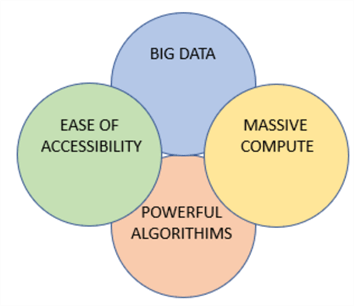
Understanding AI Technologies and Capabilities
According to Wikipedia, the term "artificial intelligence" is often used to describe machines (or computers) that mimic "cognitive" functions that humans associate with the human mind, such as "learning" and "problem solving".
With AI, machines can learn from big datasets over time without direct intervention, interpret the meaning of text, voice and image data and finally form a conclusion from a variety of structured, unstructured, and constantly evolving datasets. Additionally, machine learning creates algorithms varying from simple linear functions to extremely complex ones, like an artificial neural network.
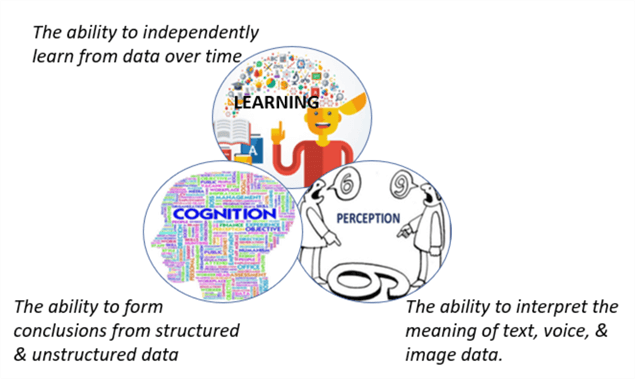
Microsoft's AI Azure Cognitive Services
The goal of a successful AI Strategy might be to bring AI to every application, business process and employee. Microsoft’s ever growing and evolving Cognitive services brings both SaaS AI (optimized for time to market) and Custom AI (optimized for flexibility) to organizations in a democratized fashion.
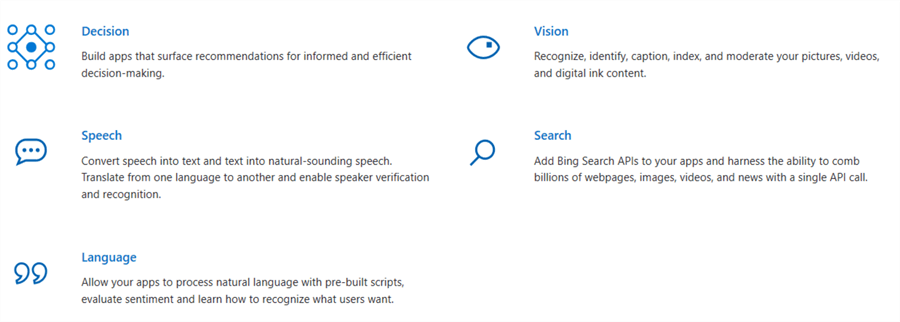
Deep Learning and Machine Learning
To be prepared to create an AI driven culture and strategy, it will be important to understand the key differences between Machine Learning and Deep Learning.
Microsoft’s article Deep Learning vs Machine Learning describes the key differences between machine learning and deep learning along with use cases for each.
Defining a Value-added AI Strategy
Digital Innovation and Transformation across industries.
With all the excitement around AI, there has been significant investments from venture capitalists and technology companies around the future of AI and the value it brings to companies and societies.
Venture capital funding of AI companies soared 72 percent last year, hitting a record $9.3 billion, according to a new report from PwC and CB Insights.
AI Venture Capital Funding

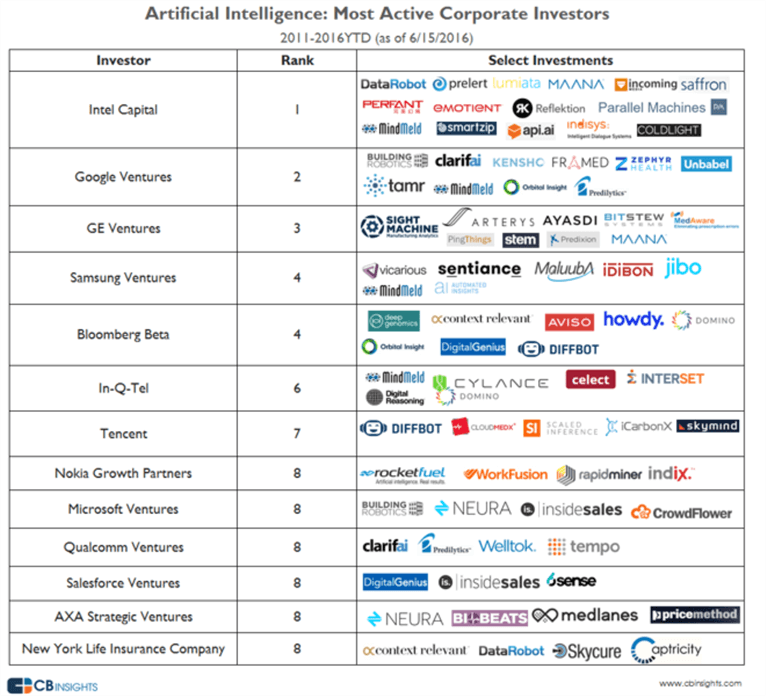
Approaches to Implementing AI
Empower development teams with SaaS AI
With the IT Department being at the heart of designing and developing AI solutions, it is important that they are empowered to deliver innovative results by teaching them about the functional and technical capabilities of AI through hands on training and learning opportunities.
Integrate Existing Applications with AI
There are many new democratized SaaS AI that can be integrated into existing applications for a quick win which would demonstrate the value for continued investments in AI.
Embrace both structured and unstructured data with AI
The combination of structured organizational data coupled with extremely big unstructured datasets utilized by AI models and algorithms might tell an extremely interesting and value-added story.
Possess a citizen data-scientist mindset
When non-technical employees are able to leverage the benefits of AI to explore vast amounts of data, they become "Citizen data scientists" are non-technical employees that are able to easily utilize self-service AI and Data Science tools to explore, blend and report on big structured and unstructured datasets. According to Gartner, "by 2019, citizen data scientists will surpass data scientists in terms of the amount of advanced analysis they produce."
Components of a successful AI Strategy
- Evaluate the current industry for trends and potential for competitive advantages by using AI.
- Identify opportunities to create significant value that will justify the commitment and investment in AI.
- Champion change and buy in by identifying organizational stakeholders that can drive the strategic vision of AI forward.
Champion an Organizational Culture Aligned with AI
Identify opportunities for change to achieve an AI-ready culture.
- Becoming a data-driven organization with standard industry leading data practices coupled with self-service data, AI and BI will be critical.
- Empowering cross-functional collaboration and inclusion across teams will promote creative digital transformation.
- Creating a plan for addressing questions and concerns about ethical and responsible AI.
Apply the AI Maturity Model Assessment to your business.
It has been estimated that over 95% of companies that have completed the AI Maturity Model Assessment are between the foundational and aspirational stages and only 4% of companies consider themselves to be mature. This opens the opportunity for empowering organizations to become Data and AI driven organizations.
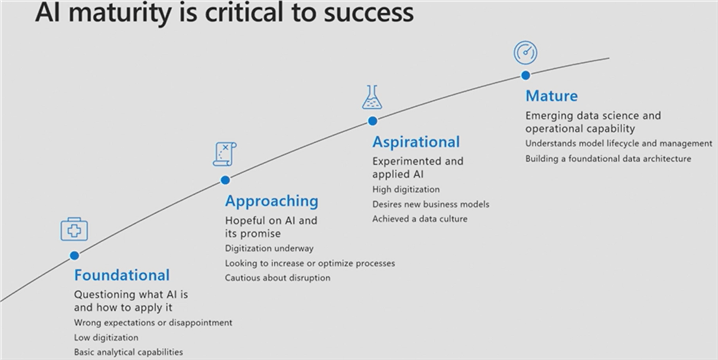
Complete the AI Maturity Assessment and download the results to understand how to advance your organization to the next level.
Establish Guidelines for Responsible AI
Microsoft’s AI Business School Identifies six guiding principles to develop and use AI responsibly.
Fairness
AI Systems should aim to eliminate bias and treat everyone fairly by understanding how bias can be introduced into an AI model and then identify steps to mitigate bias by diversifying datasets and implementing controls to detect and eliminate bias.
Reliability and Safety
Reliable and Safe AI Systems operate as they are intended to despite any unsupervised changes. Continuous governance and oversight equally important as rigorously testing the system prior to deployment.
Privacy and Security
Compliance around the privacy and security data used by AI systems will be critical.
Inclusiveness
Inclusive design practices can help address barriers that could unintentionally exclude people.
Transparency
Having a transparent view of the AI System’s model and logic will help with improving their intelligibility and identify biases, reliability, and privacy concerns.
Accountability
AI Systems that affect people’s lives in an autonomous way should be regulated, governed and ultimately hold the creators of the AI System accountable for the decisions made.
Determine the elements of an AI governance system.
Legal and Ethical Oversight
Microsoft’s AI Business School recommends a few key opportunities for legal and ethical oversight such creating an Ethics Office comprised of an ethics committee managed by a Chief Ethics Officer to cover and develop aspects of ethical responsibilities and oversight.
AI System Processes and Policies
It will also be critical to create policies that define how AI is deployed, managed and maintained as well as identifying opportunities to track biases and privacy concerns.
AI System Stakeholder Feedback
Microsoft focuses on joining industry initiatives to influence policy by participating and collaborating in industry coalitions and constantly getting stakeholder feedback for existing AI Systems.
Next Steps
- For more information on Democratization of AI, read "What Democratization of AI Means for Enterprise IT"
- For a more detailed comparison of Machine learning and Deep learning, read Microsoft’s article "Deep Learning vs. Machine Learning"
- Check out Microsoft Azure’s Cognitive Services for more information on transforming your business with AI.
- Visit Microsoft’s AI School to continue learning more about recommended AI Strategies and Services.
- Check out Microsoft’s AI and Machine Learning reference architectures.
- Explore learning paths and hands on modules for the AI Engineer role.
About the author
 Ron L'Esteve is a trusted information technology thought leader and professional Author residing in Illinois. He brings over 20 years of IT experience and is well-known for his impactful books and article publications on Data & AI Architecture, Engineering, and Cloud Leadership. Ron completed his Master’s in Business Administration and Finance from Loyola University in Chicago. Ron brings deep tec
Ron L'Esteve is a trusted information technology thought leader and professional Author residing in Illinois. He brings over 20 years of IT experience and is well-known for his impactful books and article publications on Data & AI Architecture, Engineering, and Cloud Leadership. Ron completed his Master’s in Business Administration and Finance from Loyola University in Chicago. Ron brings deep tecThis author pledges the content of this article is based on professional experience and not AI generated.
View all my tips






